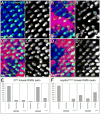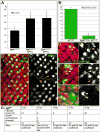Combinatorial signaling by the Frizzled/PCP and Egfr pathways during planar cell polarity establishment in the Drosophila eye
- PMID: 18291359
- PMCID: PMC2579749
- DOI: 10.1016/j.ydbio.2008.01.016
Combinatorial signaling by the Frizzled/PCP and Egfr pathways during planar cell polarity establishment in the Drosophila eye
Abstract
Frizzled (Fz)/PCP signaling regulates planar, vectorial orientation of cells or groups of cells within whole tissues. Although Fz/PCP signaling has been analyzed in several contexts, little is known about nuclear events acting downstream of Fz/PCP signaling in the R3/R4 cell fate decision in the Drosophila eye or in other contexts. Here we demonstrate a specific requirement for Egfr-signaling and the transcription factors Fos (AP-1), Yan and Pnt in PCP dependent R3/R4 specification. Loss and gain-of-function assays suggest that the transcription factors integrate input from Fz/PCP and Egfr-signaling and that the ETS factors Pnt and Yan cooperate with Fos (and Jun) in the PCP-specific R3/R4 determination. Our data indicate that Fos (either downstream of Fz/PCP signaling or parallel to it) and Yan are required in R3 to specify its fate (Fos) or inhibit R4 fate (Yan) and that Egfr-signaling is required in R4 via Pnt for its fate specification. Taken together with previous work establishing a Notch-dependent Su(H) function in R4, we conclude that Fos, Yan, Pnt, and Su(H) integrate Egfr, Fz, and Notch signaling input in R3 or R4 to establish cell fate and ommatidial polarity.
Figures







Similar articles
-
Frizzled/PCP-dependent asymmetric neuralized expression determines R3/R4 fates in the Drosophila eye.Dev Cell. 2006 Dec;11(6):887-94. doi: 10.1016/j.devcel.2006.09.016. Dev Cell. 2006. PMID: 17141162
-
Notch signaling coordinates ommatidial rotation in the Drosophila eye via transcriptional regulation of the EGF-Receptor ligand Argos.Sci Rep. 2019 Dec 9;9(1):18628. doi: 10.1038/s41598-019-55203-w. Sci Rep. 2019. PMID: 31819141 Free PMC article.
-
Ral GTPase promotes asymmetric Notch activation in the Drosophila eye in response to Frizzled/PCP signaling by repressing ligand-independent receptor activation.Development. 2011 Apr;138(7):1349-59. doi: 10.1242/dev.056002. Epub 2011 Feb 24. Development. 2011. PMID: 21350007 Free PMC article.
-
Wnt-Frizzled/planar cell polarity signaling: cellular orientation by facing the wind (Wnt).Annu Rev Cell Dev Biol. 2015;31:623-46. doi: 10.1146/annurev-cellbio-100814-125315. Annu Rev Cell Dev Biol. 2015. PMID: 26566118 Free PMC article. Review.
-
Planar cell polarity signaling: coordination of cellular orientation across tissues.Wiley Interdiscip Rev Dev Biol. 2012 Jul-Aug;1(4):479-99. doi: 10.1002/wdev.32. Wiley Interdiscip Rev Dev Biol. 2012. PMID: 23066429 Free PMC article. Review.
Cited by
-
c-Fos Repression by Piwi Regulates Drosophila Ovarian Germline Formation and Tissue Morphogenesis.PLoS Genet. 2016 Sep 13;12(9):e1006281. doi: 10.1371/journal.pgen.1006281. eCollection 2016 Sep. PLoS Genet. 2016. PMID: 27622269 Free PMC article.
-
Nemo kinase phosphorylates β-catenin to promote ommatidial rotation and connects core PCP factors to E-cadherin-β-catenin.Nat Struct Mol Biol. 2011 Jun;18(6):665-72. doi: 10.1038/nsmb.2049. Epub 2011 May 8. Nat Struct Mol Biol. 2011. PMID: 21552260 Free PMC article.
-
Multiscale modeling of form and function.Science. 2009 Apr 10;324(5924):208-12. doi: 10.1126/science.1170107. Science. 2009. PMID: 19359578 Free PMC article. Review.
-
AKAP200 promotes Notch stability by protecting it from Cbl/lysosome-mediated degradation in Drosophila melanogaster.PLoS Genet. 2018 Jan 8;14(1):e1007153. doi: 10.1371/journal.pgen.1007153. eCollection 2018 Jan. PLoS Genet. 2018. PMID: 29309414 Free PMC article.
-
Tissue fluidity mediated by adherens junction dynamics promotes planar cell polarity-driven ommatidial rotation.Nat Commun. 2021 Nov 30;12(1):6974. doi: 10.1038/s41467-021-27253-0. Nat Commun. 2021. PMID: 34848713 Free PMC article.
References
-
- Adler PN. Planar signaling and morphogenesis in Drosophila. Dev Cell. 2002;2:525–535. - PubMed
-
- Bassuk AG, Leiden JM. A direct physical association between ETS and AP-1 transcription factors in normal human T cells. Immunity. 1995;3:223–37. - PubMed
-
- Boutros M, et al. Dishevelled activates JNK and discriminates between JNK pathways in planar polarity and wingless signaling. Cell. 1998;94:109–118. - PubMed
-
- Brunner D, et al. The ETS domain protein Pointed-P2 is a target of MAP kinase in the Sevenless signal transduction pathway. Nature. 1994;370:386–389. - PubMed
-
- Casci T, Freeman M. Control of EGF receptor signalling: lessons from fruitflies. Cancer Metastasis Rev. 1999;18:181–201. - PubMed
Publication types
MeSH terms
Substances
Grants and funding
LinkOut - more resources
Full Text Sources
Medical
Molecular Biology Databases
Research Materials
Miscellaneous

